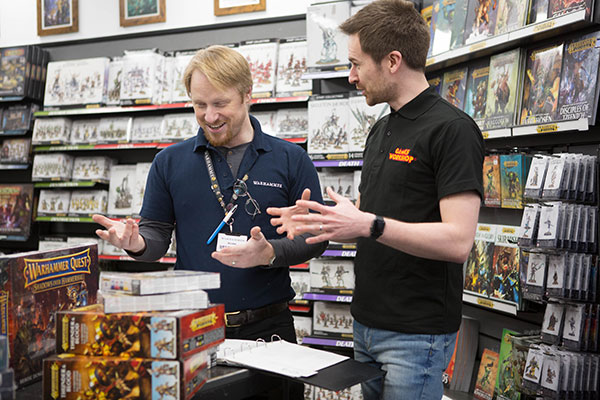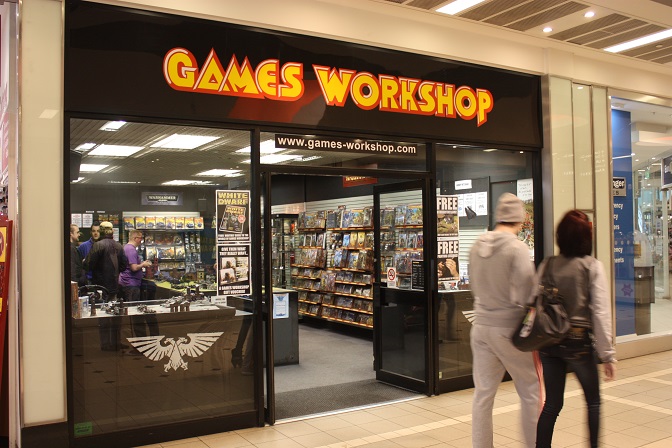Stockwatch: Games Workshop shows risks of growth stock valuations
A question of market euphoria, and whether it can be supported by fundamentals.
19th March 2021 13:13
by Edmond Jackson from interactive investor
A question of market euphoria, and whether it can be supported by fundamentals.

Is a 7% fall in the share price of Games Workshop (LSE:GAW), the producer of Warhammer miniature games chiefly company-specific?
Or is it more widely relevant as an example of how market euphoria cannot now be supported by fundamentals and sentiment is liable to break down?
Its market value of more than £3 billion does seem high for a fairly specific games manufacturer. Yet Games Workshop is very well established and popular across the US, Europe and Australasia.
A heavy price does not alone imply ‘over-valued’
A first and key point to appreciate is that while a current price around £94 - down from an all-time high of £112 in the new year – seems very expensive, price can have little bearing on value.
This company has 32.8 million shares in issue, which is relatively low versus those busily issuing for acquisitions and employee bonuses. A low number of shares is a good sign, reflecting a cash-generative business able to self-fund its investment needs. Cash flow per share from operations is consistently and materially ahead of earnings per share, versus moderate capital expenditure – to keep refreshing designs.
But yes, the near-term chart looks toppy in context of a five-year parabolic rise, and an approximate doubling in value since lockdowns began a year ago. Recently the ex-chairman and his wife sold nearly half their stake, a classic act of risk management.
- How long before Games Workshop makes it to the FTSE 100?
- 41 growth stocks for 2021
- Best and worst FTSE 250 stocks of 2020
Assuming Games Workshop makes around £120 million net profit going forward, its forward price-to-earnings (PE) ratio is around 25x – nowhere near as rich as many US ‘growth’ valuations but high enough to mean a scant sub-2.5% yield despite paying out roughly half of earnings.
Three expectations beaten in a row, then ‘in line’
It supports that theory that the chart drop is stock-specific.
A year ago, the narrative was pretty dire, like many. With global performance already hit by the pandemic, all Games Workshop’s stores, headquarters, factories and warehouses had been shut down. But its annual results to end-May still proved the best in its history.
The goal was re-asserted: to make the best fantasy miniatures in the world “for a price we believe represents the investment in their quality”.
It has still helped operating margins soar from around 14% to 33% in recent years, hence an enviable aspect of operational gearing which does make profit sensitive to revenue changes.
This was shown by the first expectations beat in a 10 September update: the company’s first quarter showing like-for-like sales up 15% to £90 million and operating profit before royalty income up 61% to £28 million. Royalty income rose 50% to £3 million.
Online and trade channels had quickly substituted stores and lockdowns.
On 6 November, another ‘ahead of expectations’ update cited first half-year pre-tax profit up at least 37% to £80 million. By 7 December this was upgraded to not less than £90 million.
Now the company reports it is “in line”, but relative to the hysteria common in late-stage bull markets generally many traders would interpret that as ‘behind’ the trend.
Chart has consolidated lately
A circa 7% drop later this week is in fact consistent with a downtrend from £117.30 on 6 January. Indeed, from 3-8 March the price fell over 9% from £100.50 to £91.35 despite no adverse news from the company.
It is also consistent with portfolio switching from ‘growth’ to ‘value’ situations although investors sitting on big gains here are likely alert to the chart. Over five years, Games Workshop has multiplied in value more than 20 times over, and January’s all-time high represented a forward PE of more than 30x estimated 12-months’ forward earnings.
The likes of Microsoft (NASDAQ:MSFT) and other technology behemoths may warrant a 30x PE because they can tie customers into subscription arrangements for essential services in the modern economy.
Yet even one of the very best global games designers is subject to changes in habit.
While Games Workshop’s products have proven more durable in concept than serial fads experienced, for example, by Bluebird Toys in its listed years, it is reasonable to assume lockdowns have offered a unique boom – quite like DIY - given so many people have had time on their hands, with families at home.

Previous chairman and wife sell nearly half their stake
Last 26 February the couple sold 8,000 shares at £97.21 each, raising £737,680, and kept 8,700 shares worth around £818,000 currently.
It appeared a logical move, both to protect gains and retain a meaningful stake if Games Workshop gets acquired by a larger multinational – especially from the US, which constitutes the company’s largest source of revenue.
While speculative, it would be consistent with serial examples of British design snapped up by foreigners on our relatively open market for corporate control.
Several other disclosed shareholders also trimmed their stakes late last year. Standard Life Aberdeen from 6.7% below 5%. JP Morgan Asset Management from just over 5% to just below this level. Likewise, Norges Bank around the 3% level, and, going back to August, Tom Kirby from 4% below 3%.
There has not, however, been any disclosed selling during the chart breakdown from January.
Holders just became a little less optimistic
Games Workshop’s chart still has a message for the wider market: that despite no adverse change in fundamentals it is possible for a bull trend to reverse simply because mild hysteria eases.
Moreover, when prices are high relative to potential long-term returns, investors are more likely to follow each other’s behaviour – watching the chart.
The crux looks likely to be the full financial year’s trading update in June, when to sustain confidence management must be clear about the revenue trend as Britain slowly emerges from lockdown.
It will initially be interesting to see what might be the ‘back to school’ effect. There looks to be a risk to valuation, as the March 2020 to March 2021 period has been exceptional.
Games Workshop Group - financial summary
Year end 31 May
| 2015 | 2016 | 2017 | 2018 | 2019 | 2020 | |
| Turnover (£ million) | 119 | 118 | 158 | 221 | 257 | 270 |
| Operating margin (%) | 13.8 | 14.3 | 24.2 | 33.6 | 31.6 | 33.4 |
| Operating profit (£m) | 16.5 | 16.9 | 38.3 | 74.3 | 81.2 | 90.0 |
| Net profit (£m) | 12.3 | 13.5 | 30.5 | 59.5 | 65.8 | 71.3 |
| Reported EPS (p) | 38.3 | 42.0 | 94.5 | 182 | 201 | 218 |
| Normalised EPS (p) | 41.9 | 43.5 | 93.4 | 182 | 204 | 219 |
| Earnings per share growth (%) | 3.3 | 3.8 | 114 | 95.4 | 11.5 | 7.6 |
| Price/earnings multiple (x) | 43.1 | |||||
| Operating cashflow/share (p) | 72.7 | 75.4 | 136 | 214 | 221 | 319 |
| Capex/share (p) | 38.6 | 39.4 | 39.7 | 65.9 | 68.6 | 75.1 |
| Free cashflow/share (p) | 34.1 | 36.0 | 96.3 | 148 | 152 | 244 |
| Dividend per share (p) | 52.0 | 20.0 | 80.0 | 120 | 120 | 135 |
| Yield (%) | 1.4 | |||||
| Covered by earnings (x) | 0.7 | 2.1 | 1.2 | 1.5 | 1.7 | 1.6 |
| Cash (£m) | 12.6 | 11.8 | 17.9 | 28.5 | 29.4 | 52.9 |
| Net debt (£m) | -12.6 | -11.8 | -17.9 | -28.5 | -29.4 | -20.8 |
| Net assets/share (p) | 161 | 166 | 196 | 272 | 328 | 409 |
Source: historic Company REFS and company accounts
Risk/reward profile tilts unfavourably at current prices
The end-November balance sheet was in excellent health: only 11% of £182.2 million net assets constituted intangibles, with no goodwill. Cash had nearly doubled, to £96.5 million, and there was no debt beyond £45.3 million lease liabilities.
Yet even after the chart pull-back the stock trades around 17x net asset value – a huge premium despite ‘book value’ being far less relevant here than earnings. A circa 2.4% prospective yield does not offer a prop. This puts a lot of focus on potential changes in revenue given the earnings’ sensitivity.
There is logic to lock in at least some gains, given this stock would also be affected by further rotation from ‘growth’ to ‘value’, especially if highly-priced US stocks crack. With fresh money: ‘avoid’.
Edmond Jackson is a freelance contributor and not a direct employee of interactive investor.
These articles are provided for information purposes only. Occasionally, an opinion about whether to buy or sell a specific investment may be provided by third parties. The content is not intended to be a personal recommendation to buy or sell any financial instrument or product, or to adopt any investment strategy as it is not provided based on an assessment of your investing knowledge and experience, your financial situation or your investment objectives. The value of your investments, and the income derived from them, may go down as well as up. You may not get back all the money that you invest. The investments referred to in this article may not be suitable for all investors, and if in doubt, an investor should seek advice from a qualified investment adviser.
Full performance can be found on the company or index summary page on the interactive investor website. Simply click on the company's or index name highlighted in the article.
Disclosure
We use a combination of fundamental and technical analysis in forming our view as to the valuation and prospects of an investment. Where relevant we have set out those particular matters we think are important in the above article, but further detail can be found here.
Please note that our article on this investment should not be considered to be a regular publication.
Details of all recommendations issued by ii during the previous 12-month period can be found here.
ii adheres to a strict code of conduct. Contributors may hold shares or have other interests in companies included in these portfolios, which could create a conflict of interests. Contributors intending to write about any financial instruments in which they have an interest are required to disclose such interest to ii and in the article itself. ii will at all times consider whether such interest impairs the objectivity of the recommendation.
In addition, individuals involved in the production of investment articles are subject to a personal account dealing restriction, which prevents them from placing a transaction in the specified instrument(s) for a period before and for five working days after such publication. This is to avoid personal interests conflicting with the interests of the recipients of those investment articles.